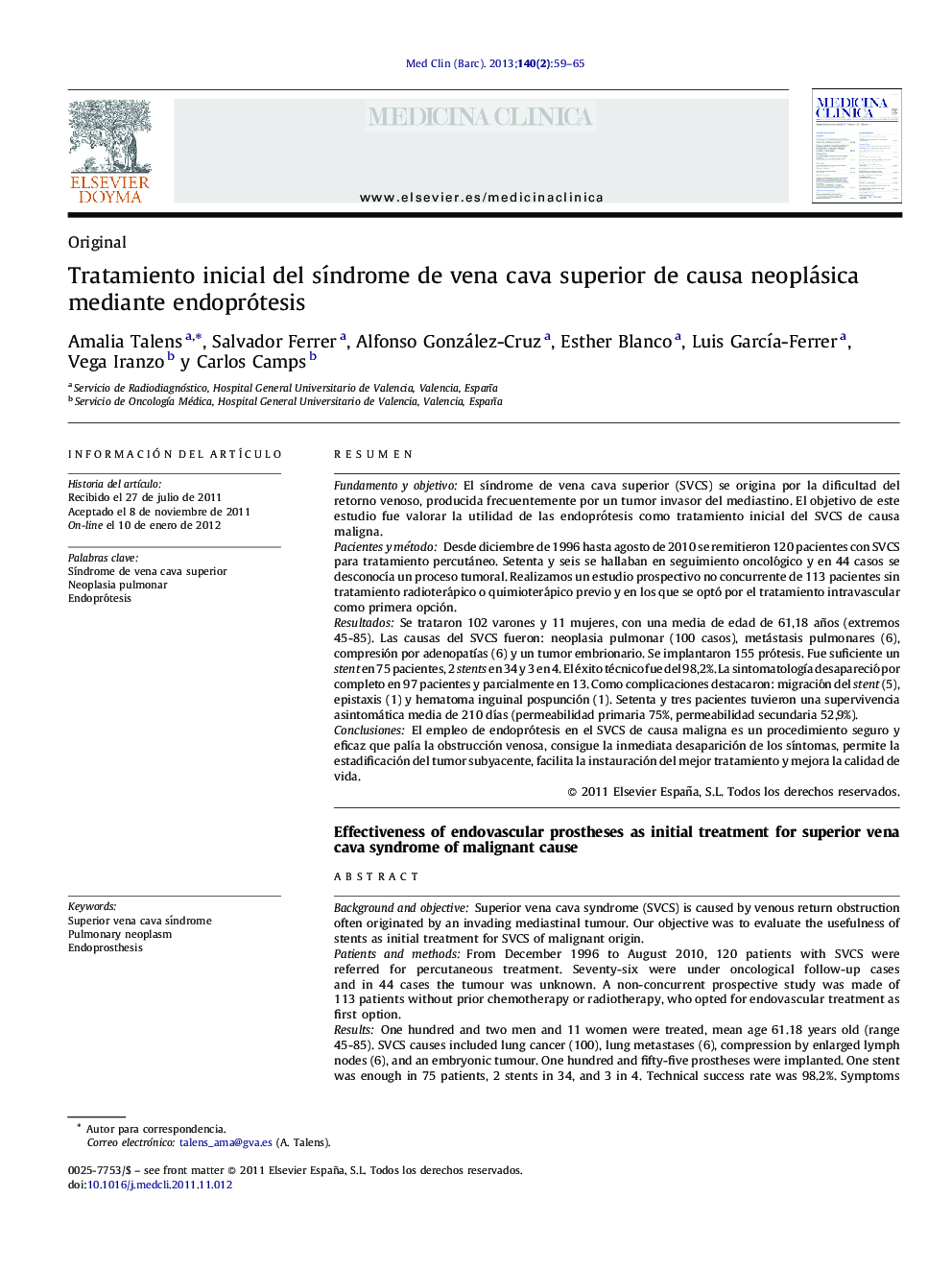| کد مقاله | کد نشریه | سال انتشار | مقاله انگلیسی | نسخه تمام متن |
|---|---|---|---|---|
| 3800119 | 1244616 | 2013 | 7 صفحه PDF | دانلود رایگان |

ResumenFundamento y objetivoEl síndrome de vena cava superior (SVCS) se origina por la dificultad del retorno venoso, producida frecuentemente por un tumor invasor del mediastino. El objetivo de este estudio fue valorar la utilidad de las endoprótesis como tratamiento inicial del SVCS de causa maligna.Pacientes y métodoDesde diciembre de 1996 hasta agosto de 2010 se remitieron 120 pacientes con SVCS para tratamiento percutáneo. Setenta y seis se hallaban en seguimiento oncológico y en 44 casos se desconocía un proceso tumoral. Realizamos un estudio prospectivo no concurrente de 113 pacientes sin tratamiento radioterápico o quimioterápico previo y en los que se optó por el tratamiento intravascular como primera opción.ResultadosSe trataron 102 varones y 11 mujeres, con una media de edad de 61,18 años (extremos 45-85). Las causas del SVCS fueron: neoplasia pulmonar (100 casos), metástasis pulmonares (6), compresión por adenopatías (6) y un tumor embrionario. Se implantaron 155 prótesis. Fue suficiente un stent en 75 pacientes, 2 stents en 34 y 3 en 4. El éxito técnico fue del 98,2%. La sintomatología desapareció por completo en 97 pacientes y parcialmente en 13. Como complicaciones destacaron: migración del stent (5), epistaxis (1) y hematoma inguinal pospunción (1). Setenta y tres pacientes tuvieron una supervivencia asintomática media de 210 días (permeabilidad primaria 75%, permeabilidad secundaria 52,9%).ConclusionesEl empleo de endoprótesis en el SVCS de causa maligna es un procedimiento seguro y eficaz que palía la obstrucción venosa, consigue la inmediata desaparición de los síntomas, permite la estadificación del tumor subyacente, facilita la instauración del mejor tratamiento y mejora la calidad de vida.
Background and objectiveSuperior vena cava syndrome (SVCS) is caused by venous return obstruction often originated by an invading mediastinal tumour. Our objective was to evaluate the usefulness of stents as initial treatment for SVCS of malignant origin.Patients and methodsFrom December 1996 to August 2010, 120 patients with SVCS were referred for percutaneous treatment. Seventy-six were under oncological follow-up cases and in 44 cases the tumour was unknown. A non-concurrent prospective study was made of 113 patients without prior chemotherapy or radiotherapy, who opted for endovascular treatment as first option.ResultsOne hundred and two men and 11 women were treated, mean age 61.18 years old (range 45-85). SVCS causes included lung cancer (100), lung metastases (6), compression by enlarged lymph nodes (6), and an embryonic tumour. One hundred and fifty-five prostheses were implanted. One stent was enough in 75 patients, 2 stents in 34, and 3 in 4. Technical success rate was 98.2%. Symptoms disappeared completely in 97 patients and partially in 13. Complications were stent migration (5), epistaxis (1), and post-procedure groin hematoma (1). Seventy-three asymptomatic patients had a mean survival of 210 days (75% primary permeability and 52.9% secondary permeability).ConclusionsThe use of stents in malignant SVCS is a safe and effective procedure for venous obstruction, leading to the immediate disappearance of symptoms, allowing the underlying tumour staging, facilitating the establishment of the best treatment and improving life quality.
Journal: Medicina Clínica - Volume 140, Issue 2, 19 January 2013, Pages 59–65